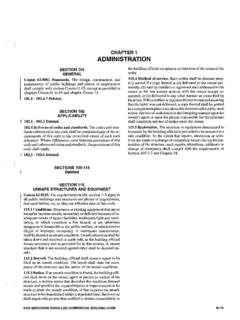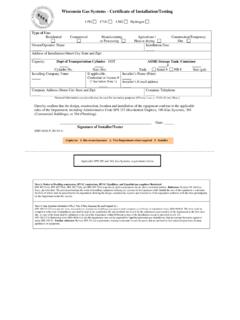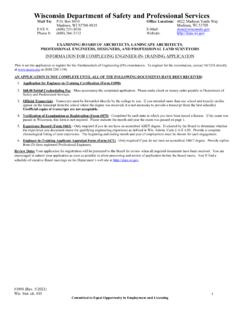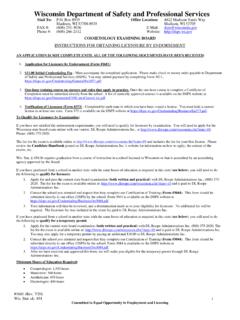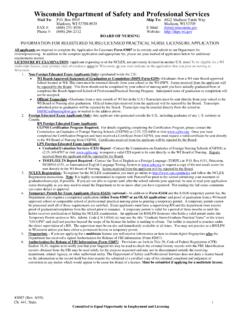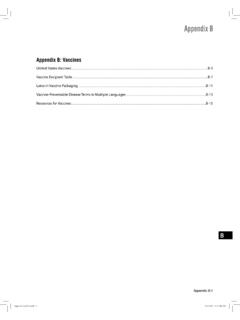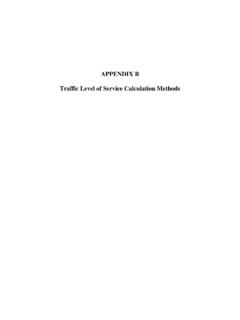Transcription of Appendix B provides an acceptable method of designing a ...
1 2016-App Comm B-1 Wisconsin Department of Safety and Professional Services Division of Industry Services 1400 East Washington Avenue Madison WI 53703 Decks are the location of many occupant deaths and injuries, many due to structural deficiencies such as inadequate connections of ledger boards, guards and posts. This code provides various prescriptive, or cookbook, methods of complying with the code requirements, that are typically conservative because of the unknown, specific project conditions. It also allows for individually engineered designs that take advantage of all specific project conditions, as well as alternate generic designs that are based on the UDC loads, materials and methods of design.
2 These generic methods can include tables, calculators, guides and other tools. Their limitations must also be followed. In some cases, these limitations will be more restrictive than that UDC, but are necessary for the overall designs to perform properly. With proper documentation, conservative substitutions or engineered substitutions may be allowed. In other cases, these alternate generic designs may differ from the UDC for issues that are not related to the need for the overall design to work. In such cases, per SPS , the UDC provisions would be the minimum and maximum enforced provisions. Appendix B provides an acceptable method of designing a deck, at the owner s option. It is mainly based on the 2012 American Wood Council's standard, Design for Code Acceptance 6 (DCA-6) Prescriptive Residential Wood Deck Construction Guide.
3 Note that DCA-6 is based on the 2012 International Residential Code. Appendix C of the UDC provides supplementary acceptable methods of designing a deck. Designs based on DCA-6 are also acceptable . Following is Appendix B with commentary in shaded italicized text. Appendix B Section Page Section Page 1 GENERAL REQUIREMENTS ..2339 LEDGER BOARD F ASTENERS .. 2432 FOOTINGS, AND POST CONNECTIONS ..23410 FREE ST ANDING DECKS ..2453 POSTS AND POST T O BEAM CONNECTIONS23611 LATERAL SUPPORT ..2464 BEAMS ..23712 DECKING ..2485 JOISTS ..23813 GUARD AND POSTS ..2486 JOIST T O BEAM CONNECTIONS ..24014 STAIRS ..2507 JOIST HANGERS ..24015 FRAMING PLAN ..2548 LEDGER ATTACHMENTS ..241 Phone: 608-266-2112 Web: Email: 2016-App Comm B-2 SECTION 1: GENERAL REQUIREMENTS 1.
4 All lumber, including for decking, must be pressure preservative treated and must be either Douglas fir/larch, hemlock/fir, spruce/pine/fir (SPF), or southern pine, of grade #2 or better unless a naturally durable species such as a western red cedar is used. Lumber in contact with the ground must be rated as ground contact." The lumber must be identified by the grade mark of, or certificate of inspection issued by, a professional lumber grading or inspection bureau or agency ( ). Note: Not all treated lumber is rated for ground contact. See Table C 1 in Appendix C for further information. See SPS of the UDC Commentary for additional information on treated lumber. 2016-App Comm B-3 2.
5 Wood plastic composites must bear a label indicating their performance criteria and compliance with ASTM D7032. Note: Wood plastic composites are materials composed of wood fibers or powder that is bound with plastic and used typically as decking and elements of a guard or handrail. Note: When using a wood plastic composite, exercise caution as some composite members do not have the same capabilities as their equivalent wood sizes. 3. Nails must be threaded, which includes ring shanked (annular grooved) and spiral grooved. Note: A 1/8 inch pilot hole is recommended for all toe nailing locations. Although not specifically required by the UDC, this requirement is included to address smooth-shanked nails backing out of wood due to moisture cycling.
6 4. All fasteners must be galvanized steel, stainless steel, or approved for use with preservative treated lumber . 5. Throughout this document, 1/2 inch diameter bolts and lag screws are specified for various connections. Edge distance and spacing requirements are based on 1/2 inch diameter fasteners. If larger (or smaller) fasteners are specified, edge distance and spacing need to be adjusted. 6. Carriage bolts may be substituted where through bolts are specified, if carriage bolt washers are installed at the bolt head. Note: Carriage bolt washers have square holes. 7. Hardware, including joist hangers or post anchors, must be galvanized steel with ounces of zinc per square foot (G 185 coating), or stainless steel.
7 All fasteners that are used with any hardware must be the same material as the hardware. All hardware must be installed in accordance with any instructions from the manufacturer. Note: For galvanized steel, look for product lines such as Zmax," Triple Zinc," or Gold Coat." Note: Galvanized steel is not compatible with stainless steel, which can result in rapid corrosion and structural failure. Note: Hardware and fasteners that are beneath a hot tub which uses salt water disinfection should be stainless steel, grade 304 or 316. 2016-App Comm B-4 Although the UDC does not require corrosion protection of connectors, the manufacturers of such connectors and treated wood typically have code-enforceable requirements for connectors used in exterior environments and with treated wood.
8 8. Every deck must have an electrical outlet along the perimeter of the deck and within feet of the floor in accordance with NEC section (E)(3). See ch. SPS 316 of the Wisconsin Administrative Code for requirements about installing electrical wiring. 9. A deck constructed in accordance with these standards is not approved for concentrated loads that exceed 40 pounds per square foot (psf), such as from privacy screens, planters, built in seating, hot tubs, stairs for multiple level decks, or from snow drift loads or sliding snow loads. Engineering analysis is needed for these loads. Note: See Appendix C for features of a deck which are somewhat uncommon or which have more complexity than is addressed in this Appendix such as design values for joists consisting of western cedar or red pine, framing details around chimneys and bay windows, or ledger boards for metal plate connected wood floor trusses.
9 Appendix C also includes reference material, such as more detailed specifications for fasteners. 10. Specifications for fasteners and hardware. All nails must meet the requirements of ASTM F1667. Wood screws must meet the requirements of ANSI/ASME Bolts and lag screws must meet the requirements of ANSI/ ASME Fasteners to be hot dipped galvanized must meet the requirements of ASTM A153, Standard Specification for Zinc Coating (Hot Dip) on Iron and Steel Hardware, Class D for fasteners 3/8" diameter and smaller or Class C for fasteners with diameters over 3/8". Fasteners other than nails and timber rivets may consist of mechanically deposited zinc coated steel with coating weights in accordance with ASTM B695, Class 55, minimum.
10 Hardware to be hot dipped prior to fabrication must meet ASTM A653 , Standard Specification for Steel Sheet, Zinc Coated (Galvanized) or Zinc Iron Alloy Coated (Galvannealed) by the Hot Dip Process, G 185 coating. Hardware to be hot dipped galvanized after fabrication must meet ASTM A123 , Specification for Zinc (Hot Dip Galvanized) Coatings on Iron and Steel Products. 11. Safety glazing at decks shall be in accordance with the safety glazing requirements of the Uniform Dwelling Code (UDC). See SPS (3) of the UDC for safety glazing requirements for glazing adjacent to doors, tubs and stairs. Be aware of SPS (6)(f) that requires any path under a deck from the discharge of an egress window to have a minimum headroom height of 36" by 36" wide for no more than 15' till free of the deck.

